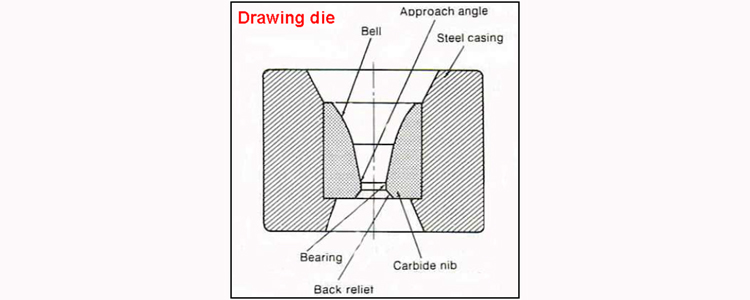
Drawing die sketch
Wire drawing involves reduction in the diameter of wire by elastic deformation achieved by passing it through a hole of smaller diameter whereas keeping the volume uniform. This tool having a small hole is called a die.
The above sketch is of a typical Drawing die with its essential parameters. These dies can be used in drawing of various materials including numerous steel alloys along with copper and aluminum alloys.
- Bell: The bell assists in guiding the wire into compression zone. The shape of bell increases the hydrostatic pressure and also causes flow of lubricant into die. The bell radii is very essential as it ensures prevention of wire-rod getting scratched & striking a sharp edge.
- Approach Angle: Proper approach angle ensures a consistent allotment of deformation forces and thermal loads. It is also known as reduction angle, as actual reduction in diameter occurs in this region, making it the working part of die.
- Die Nib: The die nib is placed carefully in a thick steel casing. This nib can be made of carbide or polycrystalline diamond. Well polished die-surface ensures minimum friction and confirms good finishing of the wire-surface. Imperfect Nib fitting can lead to nib getting crack or shatter in drawing operation.
- Bearing Region: This region causes a frictional drag on wire along with removal of any surface-damage of wire caused by die-wearing, without altering the dimensions of wire. An appropriate bearing length assures longer die life and appropriate wire-diameter, thereby providing product-quality and economical-costs.
- Back-Relief: It is at a similar angle as reduction-angle and allows the wire to expand slightly while leaving. It causes prevention of fines developed by shaving caused by any of three reasons:
- Relaxation of the elastic deformation once wire leaves the bearing area.
- Misalignment of die
- Breakage occurring during stoppage of machine, causing wire to move backwards against a sharp angle, resulting in crack.
- Proper exit: This is essential to curb drawing process related axial mechanical forces. This is very important during backlash in drawing process, which tries to pull nib out of casing from front. In such cases any chucking of nib in casing, would crack the nib, separating it into two distinct cylinders.
Bharat Industries has experience of nearly 40 years in manufacturing drawing dies, which has gained us fame as an eminent manufacturer and exporter of drawing dies in the wire-industry market. Please feel free to approach for your requirements in drawing dies and be rest assured to get the best service in Thane!
This entry was posted on Thursday, August 29th, 2013 at 9:11 pm and is belong to category Blog.




